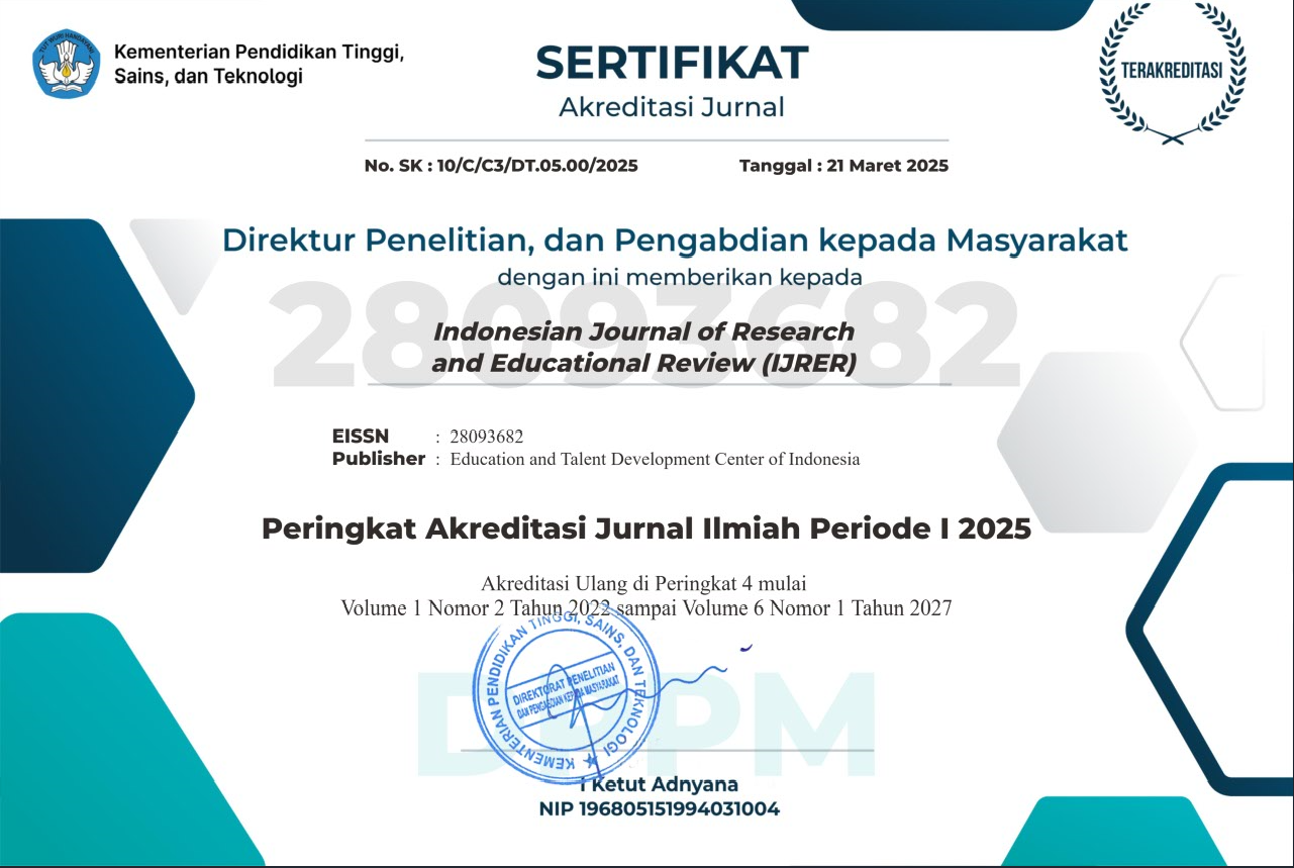Improving Students’ Speaking Skills: Effect of Varied Questioning Strategies in The Classroom
DOI:
https://doi.org/10.51574/ijrer.v1i2.390Keywords:
Speaking Skill, Varied Questioning, StrategiesAbstract
The objective of this study was to see if employing various questioning strategies improves the speaking skills of first-year students at MTs As'adiyah Putri 1 Sengkang in terms of correctness, fluency, and comprehensibility. The pre-experimental approach was used in this study. The students at MTs As'adiyah Putri 1 Sengkang made up the majority of the population. This study used a purposive sampling strategy to select one class as the sample, class VII-A, which has 30 students in the 2020/2021 academic year, because students in that class had more knowledge than students in other classes. A test of learning outcomes was used, which included speaking skills (pre-test and post-test). The findings of this study reveal that the accuracy of the students' speaking has improved. The findings of the pre-test show that just 4% of students received a score of 71–85, but 24% of students received that score in the post-test. Furthermore, on both the pre-test and post-test, the percentage of pupils in the extremely bad group was 48 percent (0 percent). The value of the sig.2-tailed is not above the level of significance (0.000 < 0.05) and also proves it. After the test, the students' speaking skills increased to a good level in response to varied questioning strategies.
References
Abrar, M., Mukminin, A., Habibi, A., Asyrafi, F., & Marzulina, L. (2018). " If our English isn't a language, what is it?" Indonesian EFL Student Teachers' Challenges Speaking English. The Qualitative Report, 23(1), 129-145.
Alsowat, H. (2016). An EFL flipped classroom teaching model: Effects on English language higher-order thinking skills, student engagement and satisfaction. Journal of Education and Practice, 7(9), 108-121. https://files.eric.ed.gov/fulltext/EJ1095734.pdf
Al-Nouh, N. A., Abdul-Kareem, M. M., & Taqi, H. A. (2015). EFL College Students' Perceptions of the Difficulties in Oral Presentation as a Form of Assessment. International Journal of Higher Education, 4(1), 136-150. http://dx.doi.org/10.5430/ijhe.v4n1p136
Al-Sobhi, B. M. S., & Preece, A. S. (2018). Teaching English speaking skills to the Arab students in the Saudi school in Kuala Lumpur: Problems and solutions. International Journal of Education and Literacy Studies, 6(1), 1-11. http://dx.doi.org/10.7575/aiac.ijels.v.6n.1p.1
Al-Zahrani, M. Y., & Al-Bargi, A. (2017). The Impact of Teacher Questioning on Creating Interaction in EFL: A Discourse Analysis. English Language Teaching, 10(6), 135-150. http://doi.org/10.5539/elt.v10n6p135
Anumanchipalli, G. K., Chartier, J., & Chang, E. F. (2019). Speech synthesis from neural decoding of spoken sentences. Nature, 568(7753), 493-498. https://doi.org/10.1038/s41586-019-1119-1
Baker, M. (2011). Brains and souls; grammar and speaking. The Soul Hypothesis: Investigations into the Existence of the Soul, edited by M. Baker and S. Goetz, 73-93.
Bashori, M., van Hout, R., Strik, H., & Cucchiarini, C. (2020). Web-based language learning and speaking anxiety. Computer Assisted Language Learning, 1-32. https://doi.org/10.1080/09588221.2020.1770293
Bernaus, M., Wilson, A., & Gardner, R. C. (2009). Teachers’ motivation, classroom strategy use, students’ motivation and second language achievement. https://doi.org/10.30827/Digibug.31869
Bonate, P. L. (2000). Analysis of pretest-posttest designs. Chapman and Hall/CRC.
Bambaeeroo, F., & Shokrpour, N. (2017). The impact of the teachers’ non-verbal communication on success in teaching. Journal of advances in medical education & professionalism, 5(2), 51. https://www.ncbi.nlm.nih.gov/pmc/articles/PMC5346168/
Creswell, J. W., & Creswell, J. D. (2017). Research design: Qualitative, quantitative, and mixed methods approaches. Sage publications.
Davies, P., & Pearse, E. (2000). Success in English Teaching: A Complete Introduction to Teaching English at Secondary School Level and Above. Oxford University Press.
Doyle, E., & Buckley, P. (2020). The impact of co-creation: an analysis of the effectiveness of student authored multiple choice questions on achievement of learning outcomes. Interactive Learning Environments, 1-10. https://doi.org/10.1080/10494820.2020.1777166
Edmondson, A. C. (2003). Speaking up in the operating room: How team leaders promote learning in interdisciplinary action teams. Journal of management studies, 40(6), 1419-1452. https://doi.org/10.1111/1467-6486.00386
Eliasson, N., Karlsson, K. G., & Sørensen, H. (2017). The role of questions in the science classroom–how girls and boys respond to teachers’ questions. International Journal of Science Education, 39(4), 433-452. https://doi.org/10.1080/09500693.2017.1289420
Farahian, M., & Rezaee, M. (2012). A case study of an EFL teacher's type of questions: An investigation into classroom interaction. Procedia-Social and Behavioral Sciences, 47, 161-167. https://doi.org/10.1016/j.sbspro.2012.06.631
Febriantini, W. A., Fitriati, R., & Oktaviani, L. (2021). An analysis of verbal and non-verbal communication in autistic children. Journal of Research on Language Education, 2(1), 53-56. https://doi.org/10.33365/jorle.v2i1.923
Friedman, J. (2013). Question‐directed attitudes. Philosophical Perspectives, 27(1), 145-174. https://doi.org/10.1111/phpe.12026
Ge, X., Chen, C. H., & Davis, K. A. (2005). Scaffolding novice instructional designers' problem-solving processes using question prompts in a web-based learning environment. Journal of educational computing research, 33(2), 219-248. https://doi.org/10.2190/5F6J-HHVF-2U2B-8T3G
Hamiloğlu, K., & Temiz, G. (2012). The impact of teacher questions on student learning in EFL. Journal of Educational and Instructional Studies in the world, 2(2), 1-8.
Hasanudin, C., & Fitrianingsih, A. (2020). Verbal Linguistic Intelligence of the First-Year Students of Indonesian Education Program: A Case in Reading Subject. European Journal of Educational Research, 9(1), 117-128. https://doi.org/10.12973/eu-jer.9.1.117
Hincks, R. (2010). Speaking rate and information content in English lingua franca oral presentations. English for specific purposes, 29(1), 4-18. https://doi.org/10.1016/j.esp.2009.05.004
Huda, N. (2016). A national strategy in achieving English communicative ability: Globalisation perspectives. Jurnal Ilmu Pendidikan, 4. http://dx.doi.org/10.17977/jip.v4i0.1298
Kassim, H., & Ali, F. (2010). English communicative events and skills needed at the workplace: Feedback from the industry. English for specific purposes, 29(3), 168-182. https://doi.org/10.1016/j.esp.2009.10.002
Kuliahana, A., & Marzuki, A. G. (2020). Repetition Technique in an EFL Speaking Class in Islamic Higher Education in Indonesia. Academic Journal Perspective: Education, Language, and Literature, 8(1), 20-28. http://dx.doi.org/10.33603/perspective.v8i1.3295
Light, J., & McNaughton, D. (2014). Communicative competence for individuals who require augmentative and alternative communication: A new definition for a new era of communication?. Augmentative and Alternative Communication, 30(1), 1-18. https://doi.org/10.3109/07434618.2014.885080
Malik, M., Malik, M. K., Mehmood, K., & Makhdoom, I. (2021). Automatic speech recognition: a survey. Multimedia Tools and Applications, 80(6), 9411-9457. https://doi.org/10.1007/s11042-020-10073-7
Marsden, E., & Torgerson, C. J. (2012). Single group, pre-and post-test research designs: Some methodological concerns. Oxford Review of Education, 38(5), 583-616. https://doi.org/10.1080/03054985.2012.731208
McTighe, J., & Wiggins, G. (2013). Essential questions: Opening doors to student understanding. Ascd.
Mehring, J. (2016). Present research on the flipped classroom and potential tools for the EFL classroom. Computers in the Schools, 33(1), 1-10. https://doi.org/10.1080/07380569.2016.1139912
Mustika, N., Nurkamto, J., & Suparno, S. (2020). Influence of Questioning Techniques in EFL Classes on Developing Students' Critical Thinking Skills. International Online Journal of Education and Teaching, 7(1), 278-287. http://iojet.org/index.php/IOJET/article/view/774
Nakatani, Y. (2010). Identifying strategies that facilitate EFL learners' oral communication: A classroom study using multiple data collection procedures. The Modern Language Journal, 94(1), 116-136. https://doi.org/10.1111/j.1540-4781.2009.00987.x
Nashruddin, N., & Ningtyas, P. R. (2020). English as Foreign Language (EFL) teacher’s questioning strategies in classroom interaction. Utamax: Journal of Ultimate Research and Trends in Education, 2(1), 5-11. https://doi.org/10.31849/utamax.v2i1.3720
Ntshuntshe, Z., Gqeba, N., & Gqeba, M. (2020). Verbal Communication in Counselling and Therapy. In Counseling and Therapy. IntechOpen.
Oliveira, A. W. (2010). Improving teacher questioning in science inquiry discussions through professional development. Journal of Research in Science Teaching: The Official Journal of the National Association for Research in Science Teaching, 47(4), 422-453. https://doi.org/10.1002/tea.20345
Ramadhan, S., Indriyani, V., & Nabila, J. (2021). Dialogic-Interactive Media Design for Language Learning To Improve Speaking Activities and Skills. In Journal of Physics: Conference Series (Vol. 1779, No. 1, p. 012029). IOP Publishing. https://doi.org/10.1088/1742-6596/1779/1/012029/meta
Sari, W. (2016). The Influence of Using Talking Stick Technique to the Speaking Ability of Eleventh Grade Students at SMAN 1 GondangNganjuk. English Education: Journal of English Teaching and Research, 1(1). https://doi.org/10.29407/jetar.v1i1.262
Sedova, K., Sedlacek, M., Svaricek, R., Majcik, M., Navratilova, J., Drexlerova, A., ... & Salamounova, Z. (2019). Do those who talk more learn more? The relationship between student classroom talk and student achievement. Learning and Instruction, 63, 101217. https://doi.org/10.1016/j.learninstruc.2019.101217
Sujariati, S., Rahman, A. Q., & Mahmud, M. (2016). English teacher’s questioning strategies in EFL classroom at SMAN 1 Bontomarannu. ELT Worldwide: Journal of English Language Teaching, 3(1), 107-121. https://doi.org/10.26858/eltww.v3i1.1884
Tofade, T., Elsner, J., & Haines, S. T. (2013). Best practice strategies for effective use of questions as a teaching tool. American journal of pharmaceutical education, 77(7). https://doi.org/10.5688/ajpe777155
Zhao, C., Pandian, A., & Singh, M. K. M. (2016). Instructional Strategies for Developing Critical Thinking in EFL Classrooms. English Language Teaching, 9(10), 14-21. http://dx.doi.org/10.5539/elt.v9n10p14









1.png)













